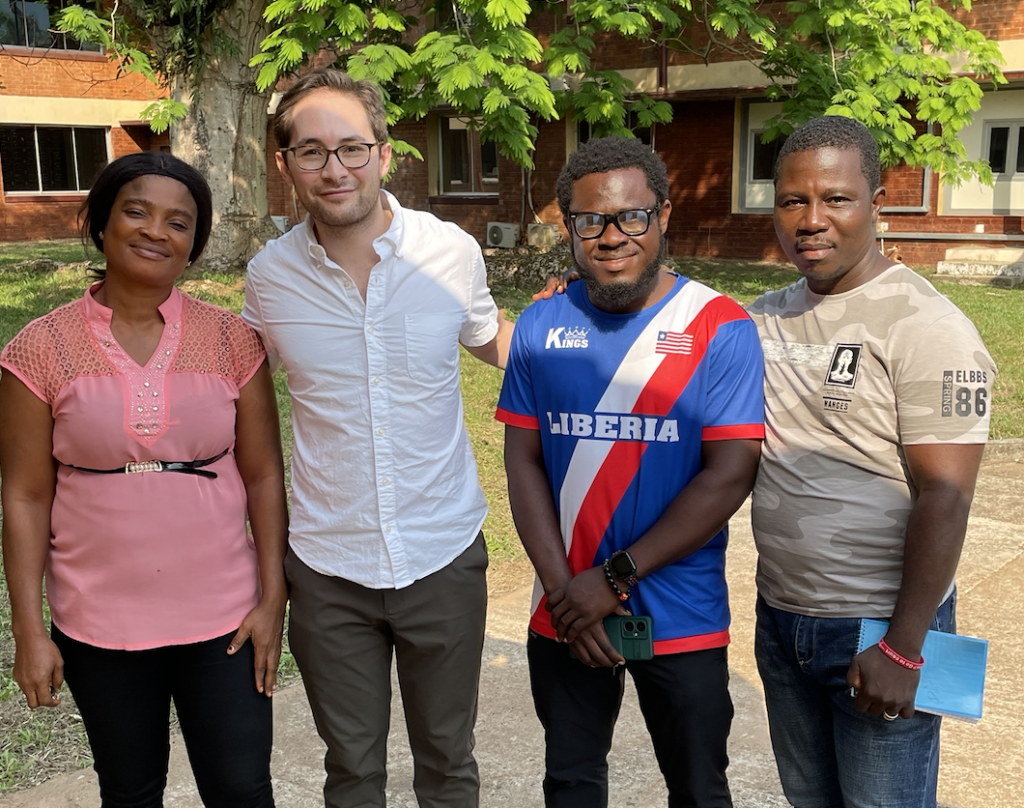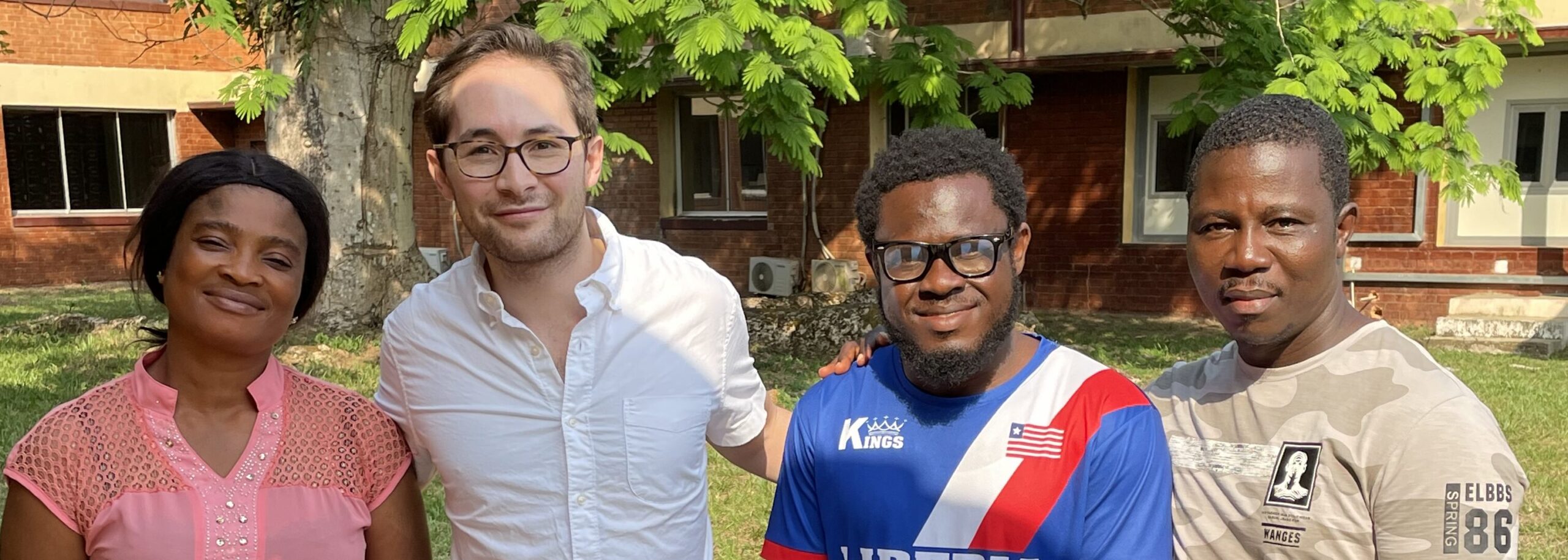Published: 05/03/2023
Interview by Jamie Hansen, Global Health Communications Manager
Seth Ari Sim-Son Hoffman, MD, MS, comes from a family of global health practitioners and since childhood has been interested in the interaction between poverty and health. But, he said, it took a literal knock on the head to help him realize he wanted to be a doctor.
Hoffman was pursuing an anthropology major and considering a career in music when he suffered a life-threatening head injury while in Indonesia for a research project. “If it weren’t for my privilege as someone with access to quality healthcare, regardless of financial means, and close family friends within the healthcare system in southeast Asia, whether I was wealthy or poor — I probably wouldn’t have survived,” he recalled. “That colored the way I thought about the rest of my career.”
Now a clinical postdoctoral fellow in the lab of Global Health Research Director Dr. Steve Luby in the Division of Infectious Diseases and Geographic Medicine, Hoffman is committed to impact-oriented research that benefits under-served communities. His recent work includes assessing methods of typhoid surveillance in Liberia and evaluating transmission dynamics of antimicrobial resistance in the context of typhoid interventions. He is also involved in work to improve indoor air quality to prevent respiratory disease transmission in schools in resource-constrained settings and evaluating infectious causes of stillbirth in Bangladesh using shotgun metagenomic sequencing.
In March 2023, Hoffman published a study in Clinical Infectious Diseases on the effectiveness of a vaccination campaign against typhoid, an ancient but underestimated disease that is one of the foremost bacterial killers of children worldwide. The study, he hopes, will help make a case for governments to invest in childhood vaccination campaigns to protect children’s lives and mitigate the development of antimicrobial-resistant typhoid.
Hoffman, an inaugural CIGH postdoctoral affiliate, discussed his recent work on typhoid, why the world should care about this deadly illness, and his commitment to research that benefits the communities it studies.
What motivates your research and commitment to global health?
Human connection is the primary motivating factor for me. That, before everything else, has driven my interest in working with under-served populations who, for much of the world, are unseen. They are there, they are human, and they deserve no less than any of us.
I am fascinated and excited every day when I get to collaborate with people from such diverse backgrounds, at Stanford and overseas, to improve the well-being of people in the most under-served populations globally.
Human connection is the primary motivating factor for me. That, before everything else, has driven my interest in working with under-served populations who, for much of the world, are unseen.
Seth Hoffman
Despite the devastating toll it takes on children in many parts of the world, typhoid is largely ignored in wealthier countries. Why should people everywhere care about this disease?
Typhoid is fascinating. It is deeply relevant to Stanford’s history – Leland Stanford Jr., the son of this university’s founder, died from the disease when he was 15 years old. Nearly 140 years later, it’s still a problem globally. In 2019, of all bacterial pathogens in the world, typhoid was the biggest killer of children between ages 5-14 — despite being a preventable disease.
It’s not sexy because it’s an old infectious disease for which we have solutions — but those solutions are being reduced as time goes on. Typhoid could become a problem again in the U.S. if we don’t control antimicrobial-resistant (AMR) typhoid. We are seeing outbreaks of AMR typhoid around the world, those strains tend to be more severe, and yet the world is not prioritizing combatting them. In the pre-antibiotic era, the case fatality rate was possibly as high as 10-15 percent. That’s high; a lot higher than the overall rate for COVID-19.
Typhoid is a disease of poverty and under-served populations. We should care because those people deserve better. COVID-19 showed us that we’re totally interconnected, and anything that happens in one corner of the world can happen in any other.
Seth HOffman
Typhoid is a disease of poverty and under-served populations. We should care because those people deserve better. COVID-19 showed us that we’re totally interconnected, and anything that happens in one corner of the world can happen in any other.
In your most recent publication, you studied the effectiveness of a childhood vaccine campaign against typhoid. What did you find?
While typhoid vaccines are not new, older vaccines do not elicit a good immune response in children, who are disproportionately impacted by typhoid. To address this, the World Health Organization (WHO)prioritized the development of a typhoid conjugate vaccine, where the original vaccine is combined with something that boosts the immune response, particularly in children. In 2017, the WHO prequalified the first typhoid conjugate vaccine for children, allowing low- and middle-income countries to procure and use them for vaccine programs with confidence.
Our paper looked at the effectiveness of a childhood vaccine program in Navi Mumbai, India. The program was led by the local municipal government in partnership with the vaccine developer, WHO-India, and the CDC. These partners contacted my mentor, Dr. Steve Luby, to help develop the study design, and I became involved when I joined Stanford. We wanted to portray to local, state, and national governments that community vaccination programs such as this one can offer a good bang for their buck.
After modifying our original study design due to COVID-19 restraints, we found that the programmatic vaccination campaign reduced the risk of individuals in the vaccinated community getting typhoid by 56 %, highlighting a significant public health benefit to communities that invest in vaccine campaigns. 71% of eligible youth in the community were vaccinated, and the vaccine had an estimated effectiveness of 82% — an incredible success. India has recently announced that it plans to integrate this vaccine into its pediatric vaccination schedule.
Tell us about the CIGH seed grant-funded project you’re doing in Liberia around typhoid surveillance.
There’s an issue with surveillance equity in typhoid. Countries like the US, which have the least burden of typhoid, have the best surveillance, whereas the countries with the greatest burden often have the least surveillance.

So, while Liberia was one of the first countries on the African continent to roll out this conjugate vaccine for its children, they did so lacking data on the burden of typhoid in children. Our partners at the National Public Health Institute of Liberia were really interested to learn more about what could be driving infection in the community, but blood cultures can be cost-prohibitive at the population level in resource-constrained settings. We wanted to support Liberia with a more cost-effective surveillance option as additional support for blood culture surveillance is developed.
Another mentor and co-PI on this project, Dr. Jason Andrews, has been monitoring water in Nepal for something called a bacteriophage — a specific virus that attacks typhoid and is only found in the presence of living typhoid bacteria. While it is hard to do surveillance for active typhoid itself, the typhoid-specific bacteriophage may be a more dependable indicator of its presence.
Using this seed funding, we’re adapting Dr. Andrews’ approach to monitor drinking water from municipal sources and pump wells for this bacteriophage. I recently returned from a visit to Liberia, where I trained lab scientists in this surveillance method. I’m very excited to see what this method can tell us about typhoid in Liberia.
Beyond typhoid, what global health topics are driving your curiosity and passion?
Seeing what’s happened with COVID-19 over the last several years really motivates my interest in planetary health and underscores the interconnection between the climate, the environment, and people. We saw how a novel respiratory virus could bring the whole world to a standstill when these factors combined.
I hope that as a global society, we have become more interested in our interconnection with one another and our environment as opposed to an “us vs. them” mentality. It would be a huge disappointment if we come out of COVID-19 and those global relationships were to fall to the wayside.
Related Reading
A recent publication in the New England Journal of Medicine, co-authored by Dr. Jason Andrews, found a high incidence of typhoid in Indian children, underscoring the life- and cost-saving potential of a national typhoid vaccination campaign. Read more in this “Take on Typhoid” article.

